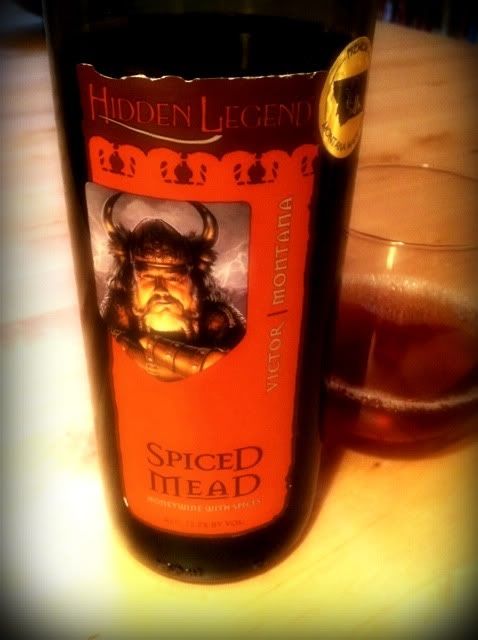An article from Fresh Vino reports that there is work being done in Montana to concentrate on cold weather grapes like Marquette, Frontenac, Traminette and Marechal Foch. They are getting some help from Pat McGlynn, who is the agricultural extension agent at Montana State University. She comes to Montana with experience at Cornell University and New York's Finger Lakes area, so she knows about cold-weather grape growing.
Many climatically-challenged areas make tasty wine from other types of fruit, like cherries, peaches and bluberries. Some take a different approach altogether. Mead.
King Tut drank mead, as did Eric The Red and Queen Elizabeth I. The story goes that someone stumbled upon a beehive that had been out in the rain. The honey inside had fermented, and that was the beginning of mead. Mead is sometimes known as honeywine. Rather than fermenting grapes, or other fruit, it's honey which undergoes fermentation and becomes "nectar of the gods," or "man's oldest drink." Joe Schultz says people were making mead a thousand years before grapes came into play.
Joe Schultz at Hidden Legend Winery makes award-winning mead using Montana honey which is not boiled, thereby avoiding the scorched flavors he says are common in meads. The Hidden Legend mead is all natural, no sulfites are added and Schultz describes his mead as "straddling the fence between dry grape wine and traditional mead." His meads all carry a modest alcohol content of 12.5% abv.
Mead can dry, sweet, still or sparkling. It can also be mixed with fruits or spices for different flavor variations. Hidden Legend Winery makes all kinds of mead. The two varieties they supplied for the Wine Country series are Wild Chokecherry and Spiced Honey Mead.
 Hidden Legend Spiced MeadLabelled as "honeywine with spices" this beverage carries a suggestion that you "heat it with a stick of cinnamon or serve it over ice with a sprig of mint." It’s a beautiful reddish-brown color, rich, dark and inviting in the glass. The nose is fascinating, with honey dripping from it and spices coloring, but not covering those notes. The aromas remind me first of a Bit-O-Honey candy, then of cinnamon and allspice, and finally a waxy scent wafting up. The honey aromas aren’t really sweet - they are reminiscent of dark honey, like avocado honey or even chestnut honey.
Hidden Legend Spiced MeadLabelled as "honeywine with spices" this beverage carries a suggestion that you "heat it with a stick of cinnamon or serve it over ice with a sprig of mint." It’s a beautiful reddish-brown color, rich, dark and inviting in the glass. The nose is fascinating, with honey dripping from it and spices coloring, but not covering those notes. The aromas remind me first of a Bit-O-Honey candy, then of cinnamon and allspice, and finally a waxy scent wafting up. The honey aromas aren’t really sweet - they are reminiscent of dark honey, like avocado honey or even chestnut honey.On the palate, the flavor of the honey comes forward first, without the sweetness. This is an off-dry honeywine with a good level of acidity and nice flavors of the spice rack which make themselves known, but don’t take over in a "holiday beverage" sort of way. This is really tasty!
 Hidden Legend Wild Chokecherry Mead
Hidden Legend Wild Chokecherry MeadThis mead is made from 60% honey mead and 40% chokecherry wine. I’ve never been to Montana, so I was unfamiliar with that fruit. It sounds like a cousin to Frankenberry, the made-up breakfast cereal fruit from childhood.
According to Schultz, the chokecherry is a wild cherry which grows throughout Montana and does not turn sweet until after a frost. Schultz says Montanans have been using chokecherries to make syrup and jam for years. He thought it would be nice to blend some chokecherry wine with his honey mead.
Its color is even redder than the Spiced Mead - a translucent cherry-red. There’s a little more of an herbal aroma on the nose, but the honey is still fully present and a layer of cherries joins in to form a truly beautiful bouquet.
The wine tastes much drier than the spiced version. The palate shows a blast of cherry Starburst candy, but in a completely dry framework. Great acidity leaves my mouth watering. I can’t help but think this chokecherry mead would pair very well with a chicken breast or pork chop.
When tasting a wine, I look mainly for four things: color, aroma, taste and acidity. The Wild Chokecherry Mead scores well on all four points. An amazing red color is joined by an intense nose and flavor package, all highlighted by a wonderful feeling of acidity in the mouth. This mead was truly a surprise for me, and it was a delight to drink.
The Hidden Legend Wild Chokecherry Mead won a gold medal in the Tasters Guild International Wine Judging, and after tasting it, I don’t wonder why.

No comments:
Post a Comment